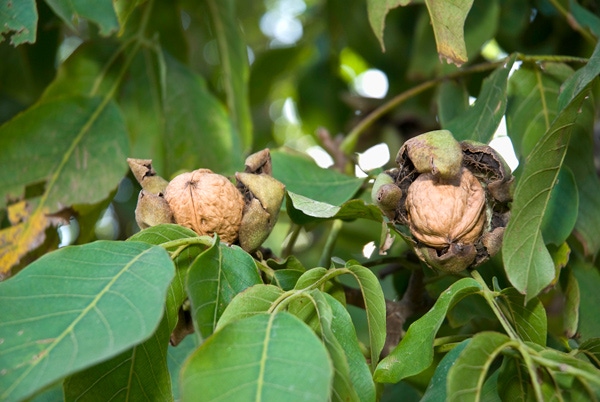
Facing a new disease threat to his orchards, Yolo County grower prepares for an early harvest
Lester has a hunch that the large amount of dead wood he’s seeing in his Hartleys this season is a combination of botryosphaeria, branch wilt disease and last December’s frost damage. What’s more, he doubts that Hartley is the only walnut variety susceptible to the disease.

It’s been a rough year for Lester Farms’ 700 acres of walnut trees near Winters, Calif.
Several days of 25- to 30-degree weather in December damaged or killed limbs and branches in some blocks. Lack of sufficient chilling hours during the winter hindered normal growth of flower and shoot buds in others. And, with the continuing shortage of rainfall, the trees were irrigated with more lower-quality ground water.
“But, considering what they’ve gone through, the trees look pretty good,” says Stan Lester. The Yolo County farmer has been growing walnuts for nearly 30 years. He was raised on his family�’s farm in Santa Clara Valley, which produced mostly prunes and walnuts.
“Then, a lot of farmers grew walnuts along the roadsides,” he says. “The story goes that these walnuts paid the property taxes.”
Today, Lester Farms grows Chandler, Hartley, Howard and Tulare walnuts along with a few Eureka and Franquette varieties.
Judging by conditions in his orchards just prior to the Labor Day weekend he’s expecting his Hartley, Howards and Tulares to produce a nice size crop this year. Last year, his Tulare yields were down from typical levels. This year, he says, the Chandler crop looks to a little on the light side.
Lester is also expecting a good quality crop. Treating his trees with Diffusion to deflect sunlight and providing them with adequate water limited sunburn damage to the nuts during a 10-day heat spell in mid-July, when temperatures reached close to 100 degrees or higher, he adds.
As a result of the continuing drought, Lester has noticed a drop in the level of his water table. Typically, it’s fairly stable, he notes. This year, he had to lower four of his wells by 20 to 40 feet. The wells in his area are pumping from depths of about 120 to 130 feet, Lester reports.
Except for the July heat spell, he’s been able to meet the water requirements of his trees this season. “We should be able to limp through the rest of the season,” he says.
Pressure in his orchards from both codling moth and walnut husk fly have been surprisingly low this season.
“It was an amazing year,” Lester says. “We only had to spray two blocks of trees for codling moth. I had expected quite the opposite, since we didn’t have a real cold winter to help keep populations down.”
He supplements the traps placed by his PCA to monitor walnut husk fly with additional traps and makes regular insecticide treatments. This approach has enabled him to stay on top of any threat before it can take hold, Lester notes.
Typically, he sprays every other row every two weeks. Lester also includes an attractant to help draw more of the pest to the material.
This season some blocks required no walnut husk fly treatment at all.
Last year, Lester began shaking his trees about a week earlier than usual. But, due to favorable growing conditions throughout this season, he expects to start his 2014 harvest even sooner or by about four to five days. That would have the shakers starting with Tulares in the third week of September.
In the meantime, Lester could begin spraying Ethrel to hasten hull cracking and separation from the shell by Labor Day.
This year, for the first time, he’s been battling botryosphaeria dieback. So far, he says, of the varieties he grows, the Hartley variety is showing the most symptoms of this yield-reducing fungal disease.
It has been around for years and has slowly developed in walnuts. University of California Cooperative Extension plant pathologists report botryosphaeria is found in the state from Kern County all the way north to Glenn County.
UCCE recommendations for controlling the disease include removing the dead wood. Lester will be doing some rough pruning of his Hartleys prior to harvest. Withholding Ethrel from the Hartleys will reduce stress on the trees from the material, he note. Also, it won’t cause leaves to drop from healthy limbs and branches, making it easier to identify the dead ones for removal after harvest.
Lester has a hunch that the large amount of dead wood he’s seeing in his Hartleys this season is a combination of botryosphaeria, branch wilt disease and last December’s frost damage. What’s more, he doubts that Hartley is the only walnut variety susceptible to the disease.
“Growers here say they’re seeing botryosphaeria mostly on Hartley,” Lester says. “But, Hartley was the predominant variety in this area for a long time. Because they’re among the oldest walnuts trees here, they’re also the most vulnerable to stress. So, you’d expect to see more dead wood on the oldest trees.
“If you look at older trees of other varieties, you’ll also see dying twigs, which some growers may blame on other factors, like shading. We haven’t seen this so much on other varieties, like Howard and Tulare, because they’re younger and haven’t been exposed to the disease for as long.”
Following UCCE recommendations, he applied fungicides to treat for botryosphaeria once in May and again in June and July.
“The UC researchers are only in their second year of studying botryosphaeria in walnuts,” he says. “Right now, there are a lot of unknowns about how to control the disease. It’s been a problem in pistachios for quite some time. But, the researchers have since determined effective ways of using fungicides to control the disease in those orchards.”
About the Author(s)
You May Also Like



